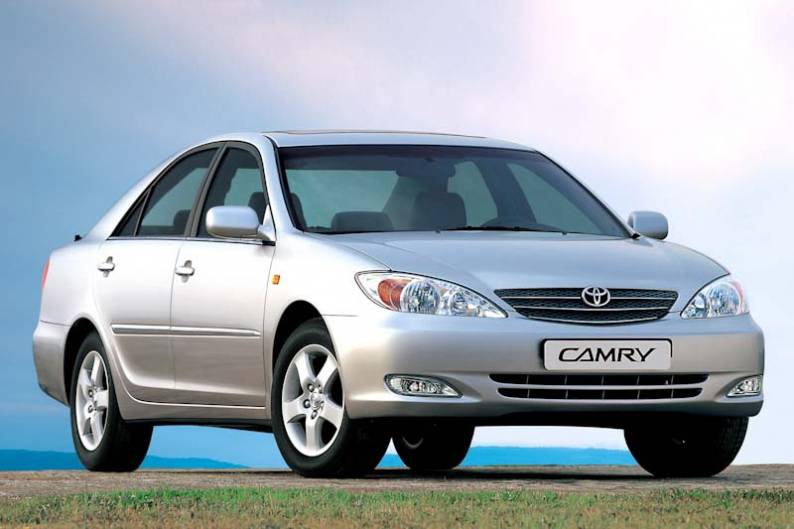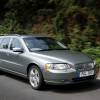
RAC sale – up to 33% off*
• Roadside cover from £5.29 a month†
• We get to most breakdowns in 60 mins or less
• Our patrols fix 4/5 breakdowns on the spot

BY ANDY ENRIGHT
Introduction
Used car buyers are always after something for nothing but by and large, the market is well up to speed on what's hot and what's not. Every once in a while something gets by the Great British public and just such a car is Toyota's post-2001 Camry. Many potential buyers firstly have no idea what a Camry is and if they do, they probably recall a car from the mid-eighties that was, at the time, little more than a Sierra or Cavalier challenger. The fifth generation Camry was a whole lot different, bringing Lexus-like quality to the mainstream Toyota range. With criminally depressed used values, these cars offer a very effective way of getting into quality used metal at a bargain price.
Models
Models Covered:
Fifth generation 2001-2004: 4dr Saloon 2.4, 3.0 V6 [GLS, CDX]
History
The Camry has been largely ignored by British buyers since its initial introduction in 1983 and Toyota's subsequent attempts to drive the car ever further upmarket only resulted in a further dwindling of sales. This must have been a puzzler as the car was a runaway hit tin the States where it was repeatedly voted the best sedan on sale.
Viewed objectively, the MK5 Camry was a very good car indeed. Launched at the 2001 Frankfurt Motor Show, the fifth-generation Camry offered a choice of 2.4 or 3.0-litre V6 petrol engines, was very well equipped and also proved effortlessly reliable. The problem was that it just didn't look the part, the styling being redolent of a rather overblown Avensis. It wasn't the sort of thing that would tempt BMW 3 Series or Audi A4 drivers to trade for something bigger and, Toyota claimed, better. It didn't help that the car also competed against the excellent Lexus IS200. Minimal sales ensued until the cars were quietly deleted in 2004.
What You Get
Toyota's task would probably have been a great deal easier in 2001 if the fourth generation Camry had been an utter dog, a genuine duffer that needed a root and branch revision. Road tests would have crowed about what a huge improvement over the outgoing model the latest car was, that here was car that had forced its way onto the executive shortlist. As it was, the previous car had been good but ignored, a fate that, it was obvious, would also befall the MK5 version, just as it would many non-premium rivals such as the Peugeot 607 and the Volvo S80. The only way to overcome such inertia would have been to introduce a genuinely boldly styled offering that would make people sit up and say, "That's a Camry?".
In this respect, the MK5 Camry proved a bit of a disappointment. Yes, it was cleanly styled, well proportioned, even rather handsome in a bland way but without any great sense of edginess, adventure or desirability. It won't make you the envy of the office car park. Get beyond the dull lines and you'll find Toyota have made a good fist of lending credence to the claim that the Camry was the car the Lexus IS200 always should have been.
What You Pay
Please fill in the form here for an exact up-to-date information.
What to Look For
Nit-picking is always tough with Japanese cars, which is good news for you, if not your mechanic's bank balance. The limited volumes of cars sold new means the importers often have to charge relatively high prices for spare parts. The way Toyota insists its suppliers build long-life components though, means you shouldn't be visiting your local dealer's warehouse too often.
Replacement Parts
(Based on a 2001 2.4 CDX - approx) A new clutch will be in the region of £225 and a full exhaust about £400. Front shock absorbers are just over £115 and the rears about £85. Front brake pads will set you back about £40, while an alternator will be around £210 and a replacement starter motor about £185.
On the Road
Buyers get to choose from two petrol engines, both of which are superb. The 2.4-litre VVTi engine makes 157bhp, a decent step up from the rather limp 128bhp that the old 2.2-litre unit fronted up with. Toyota's VVT-i (variable Valve Timing-intelligent) is responsible for this, and it does exactly what it says on the cam cover, raising torque at low speeds whilst managing to return an admirable economy figure of 32.8mpg. Insurance for the Camry is also notably kind, the 2.4-litre car being rated at a mere Group 12E. Performance is similarly impressive, the manual model hitting 60mph in 9.4 seconds and the sculpted body allowing the Camry to breach 130mph. When new, customers could choose between a five-speed manual or an electronically controlled four-speed automatic gearbox and paid prices starting at a reasonable £19,500: that was BMW 318 money.
Most buyers of previous Camry models will be quite used to the 3.0-litre V6 version and its 192bhp powerplant. Only offered with the auto 'box, the 3.0-litre hauls the Camry through 60 in 8.9 seconds and only runs out of ideas at a lofty 140mph. A fuel consumption figure of 25.7mpg is class competitive, and Toyota argued when new that their £25,500 asking price wasn't excessive when a similarly sized and specified BMW 530i SE would set buyers back another £4,000.
To be fair, the premium brands were never what Toyota was aiming at with the Camry. Instead this car always aimed to see off rivals like the Peugeot 607, the Vauxhall Omega and the lower order Saab 9-5s. As such, it campaigned using the same attributes as these cars, namely comfort, features and safety rather than any notion of a thrilling drive. Looking at the specification list of the Camry, you'd have to admit that Toyota have certainly come up trumps in the first two areas and on the road, the MK5 Camry certainly wasn't the turgid handler the MK4 version was, instead displaying a surprising lightness on its feet. The low insurance groupings for the Camry were brought about by award-winning anti-theft features as well as low cost crash repair structures. Should you relinquish control of your Camry, you'll be relieved to find that Toyota haven't skimped on safety. Dual stage SRS airbags are standard for the driver and front passenger, as are side airbags and curtain shield airbags that help protect the heads of both front and rear seat occupants. Anti-lock braking, brake assist and electronic brakeforce distribution aim to prevent any internal dirigible antics and the front seatbelts are fitted with pre-tensioners and load limiters.
Overall
The Camry is the car that proves that the used market isn't necessarily a meritocracy. There are plenty of far less accomplished cars enjoying a better reputation than this big Toyota saloon. If you want comfortable, reliable motoring in a quality car the Camry, especially in punchy 3.0-litre guise, is well worth a look. Watch the depreciation though.







